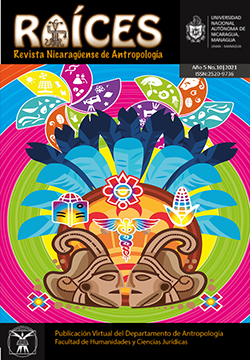Changes in eating and residence customs: case study of the Native community of Mayuariga, Loreto
DOI:
https://doi.org/10.5377/raices.v5i10.13591Keywords:
Community, Mayuriaga, culture, ethnographyAbstract
This research work aims to provide a referential framework of assessment in the context of social damage from the anthropological interpretation of the inhabitants of the native community of Mayuriaga, due to the loss of quality of life, five years after the crude oil spill by part of the Petroperú company occurred in the North Peruvian Pipeline in the Morona River area in the Morona district, Daten de Marañón province, Loreto department, Peru; affecting the lifestyle of the surrounding ethnic communities. This extra-patrimonial damage is expressed and evidenced in eating habits; and residence, in the customs of the traditional use of water, recreation, social stability (tranquility), in the economy, in medicine and in the physical spaces of socialization and social incorporation. Likewise, to know these characteristics, the ethnographic method and on-site visits to the locality that were the subject of our research were used. Finally, we indicate that a quantity of relevant information was collected on the perceptions and changes in the lifestyles of the inhabitants, this thanks to the techniques of interview and observation.
Downloads
References
Csordas, J. (1999). The Sacred Self: A Cultural Phenomenology of Charismatic Healing. Berkeley: University of California Press.
Fuentes, A. (1988). Porque las Piedras No Mueren. Historia, Sociedad y Ritos de los Chayahuitas del Alto Amazonas. Centro Amazónico de Antropología y Aplicación: Perú.
Giddens, A. (2007). Sociología. Madrid, España: Alianza Editorial. Iriarte, F. (2003). Antropología. Universidad Inca Garcilaso de la Vega: Lima – Perú.
Kalinsky, B. (2002). Antropología Jurídica. Argentina. Ochoa, N. (1990). Los Kampopiyapi. Centro Amazónico de Antropología y Aplicación: Perú.
Regan, J. (2003). Valoración Cultural de los Pueblos Awajún y Wampis. Conservación Internacional Perú-Proyecto PD 3/00 Rev.2 F-ITTO. Paz y Conservación Binacional en la Cordillera del Cóndor, Ecuador-Perú. Componente peruano. CAAP: Perú.
Downloads
Published
How to Cite
Issue
Section
License
Copyright (c) 2021 Universidad Nacional Autónoma de Nicaragua. UNAN-Managua, Nicaragua.

This work is licensed under a Creative Commons Attribution-NonCommercial-ShareAlike 4.0 International License.




